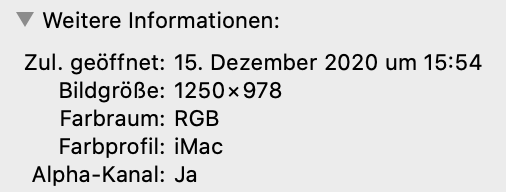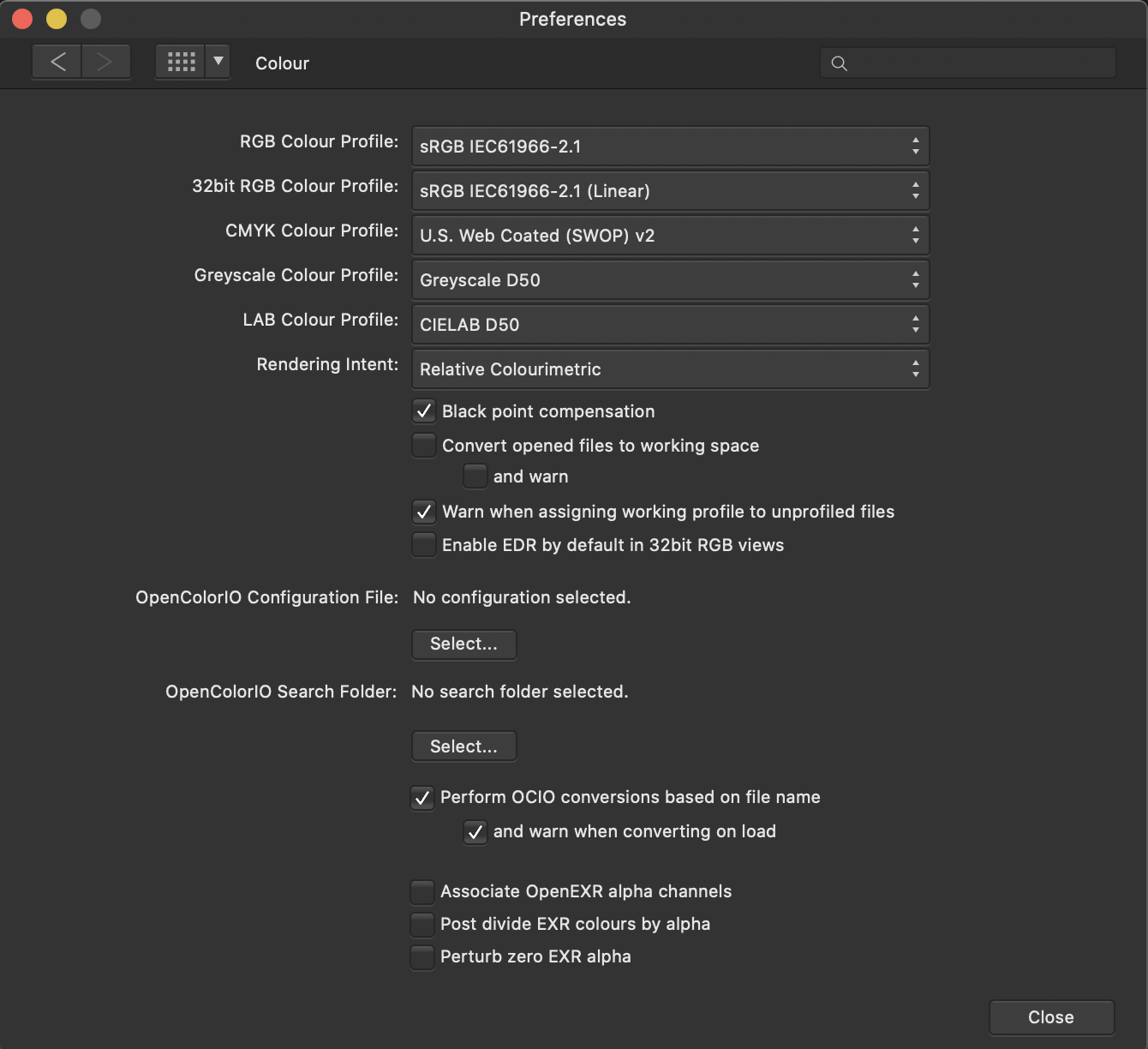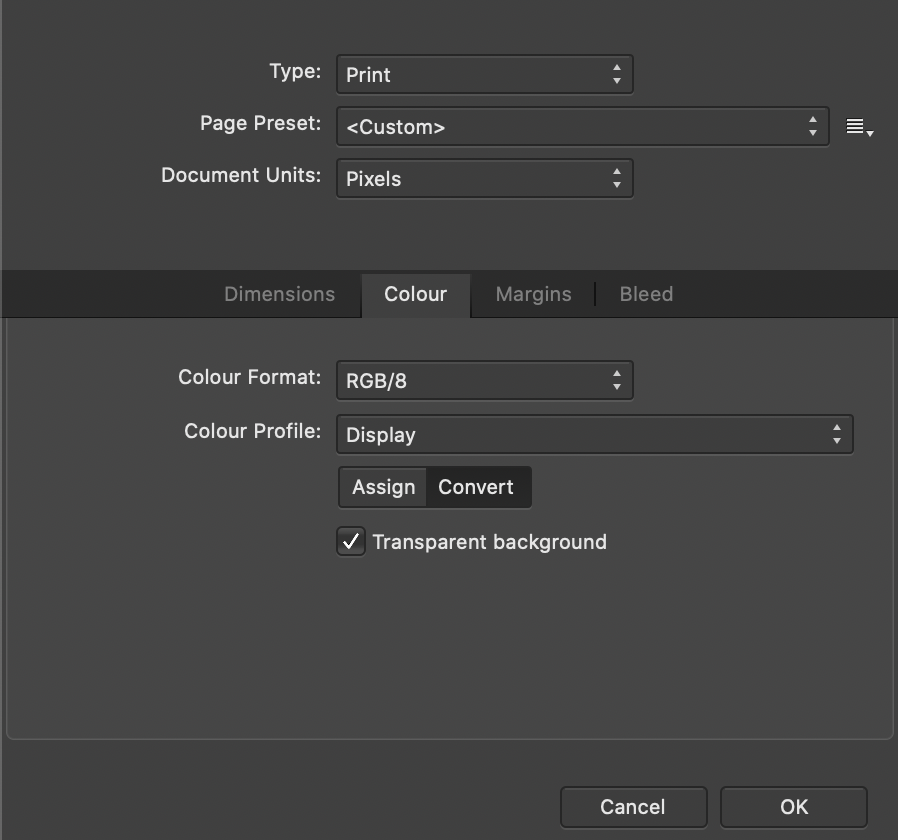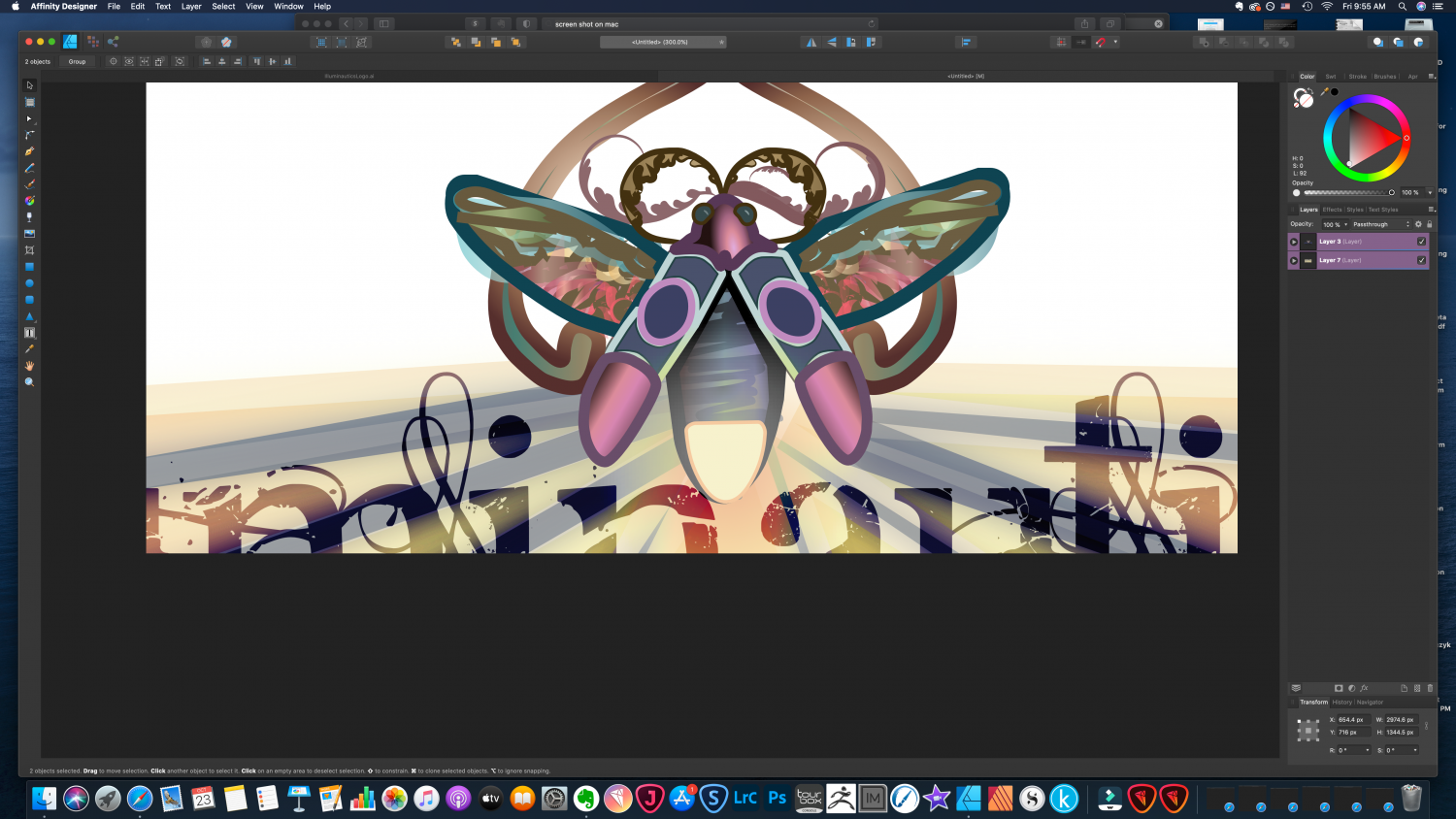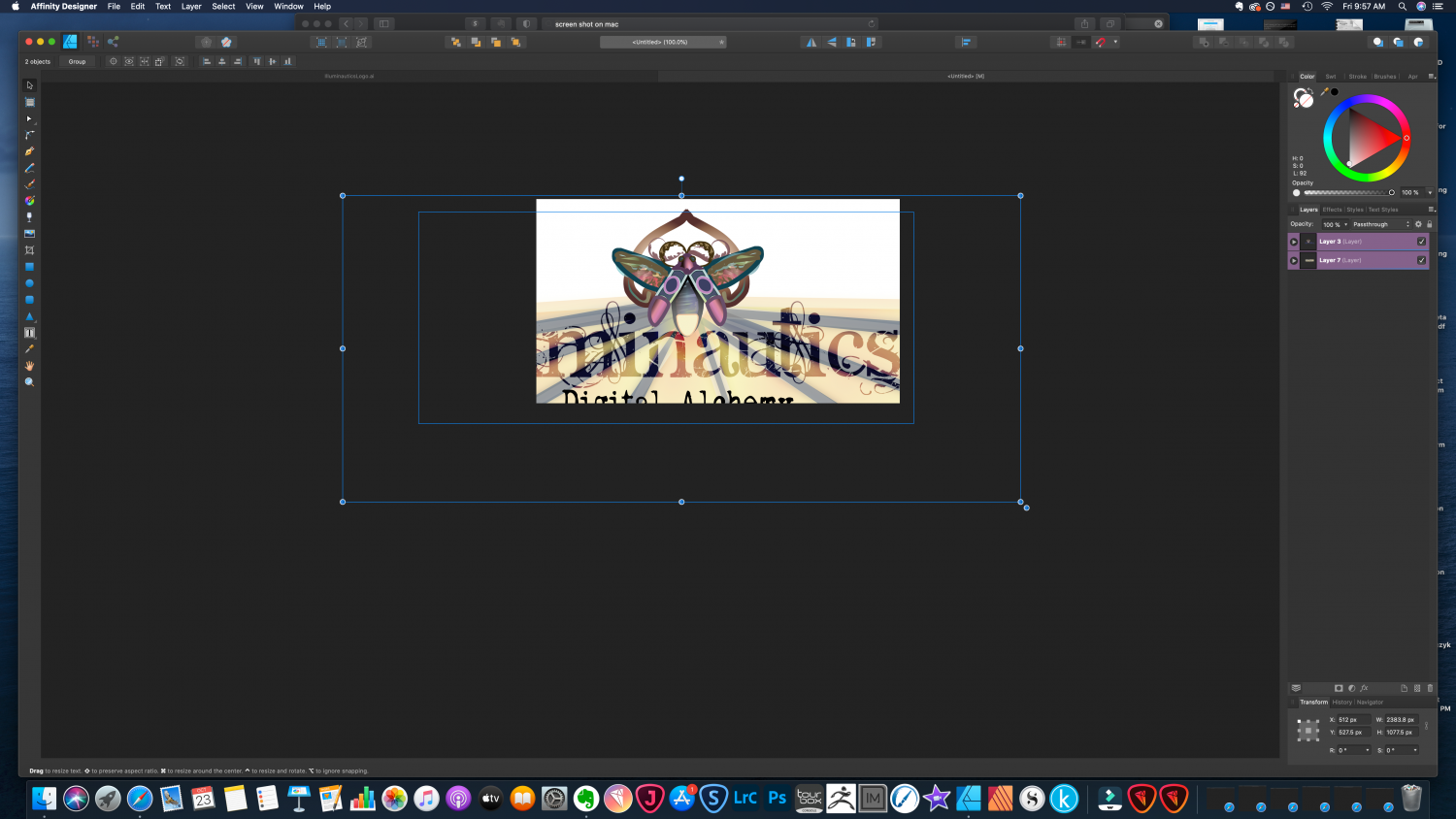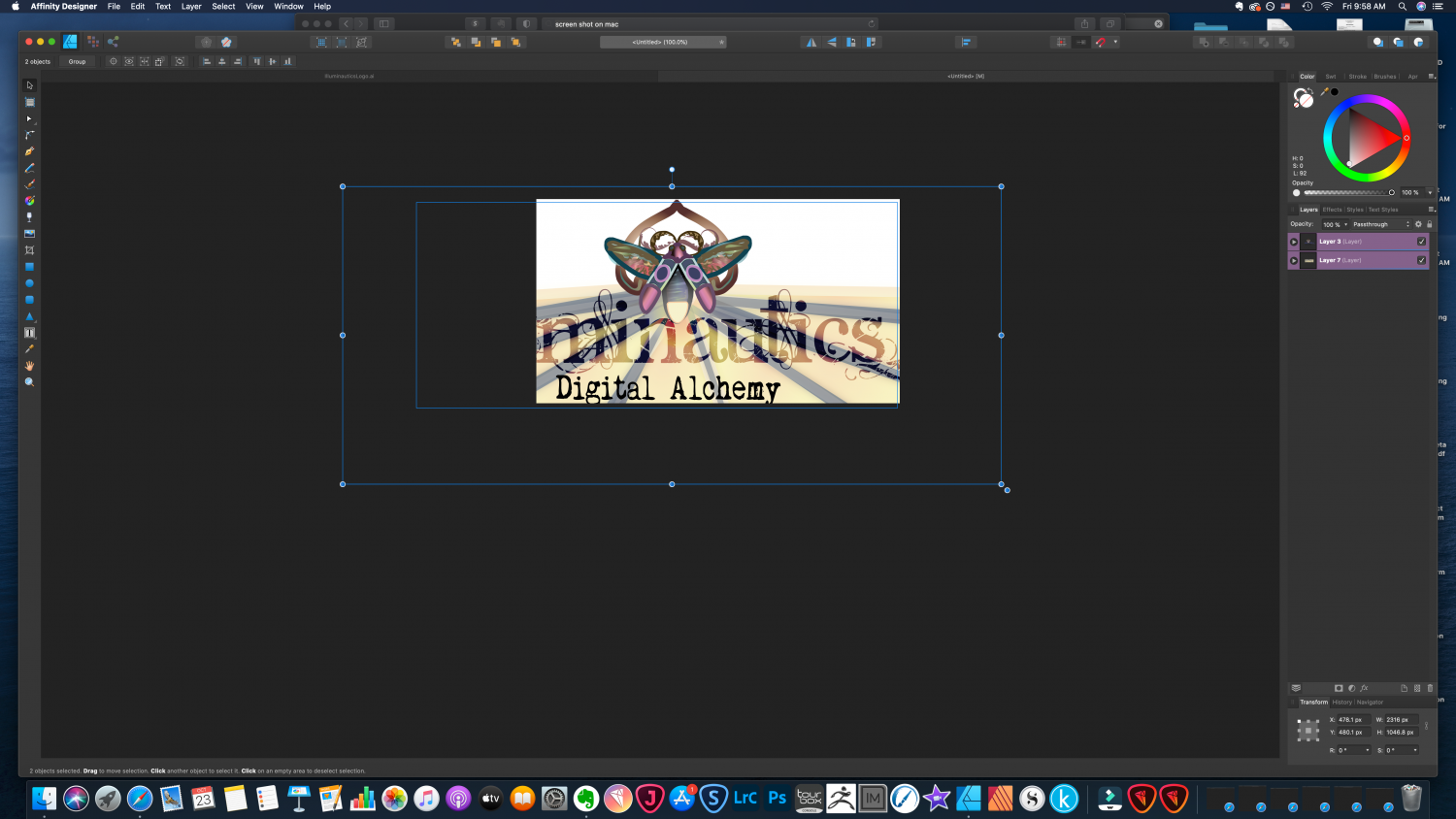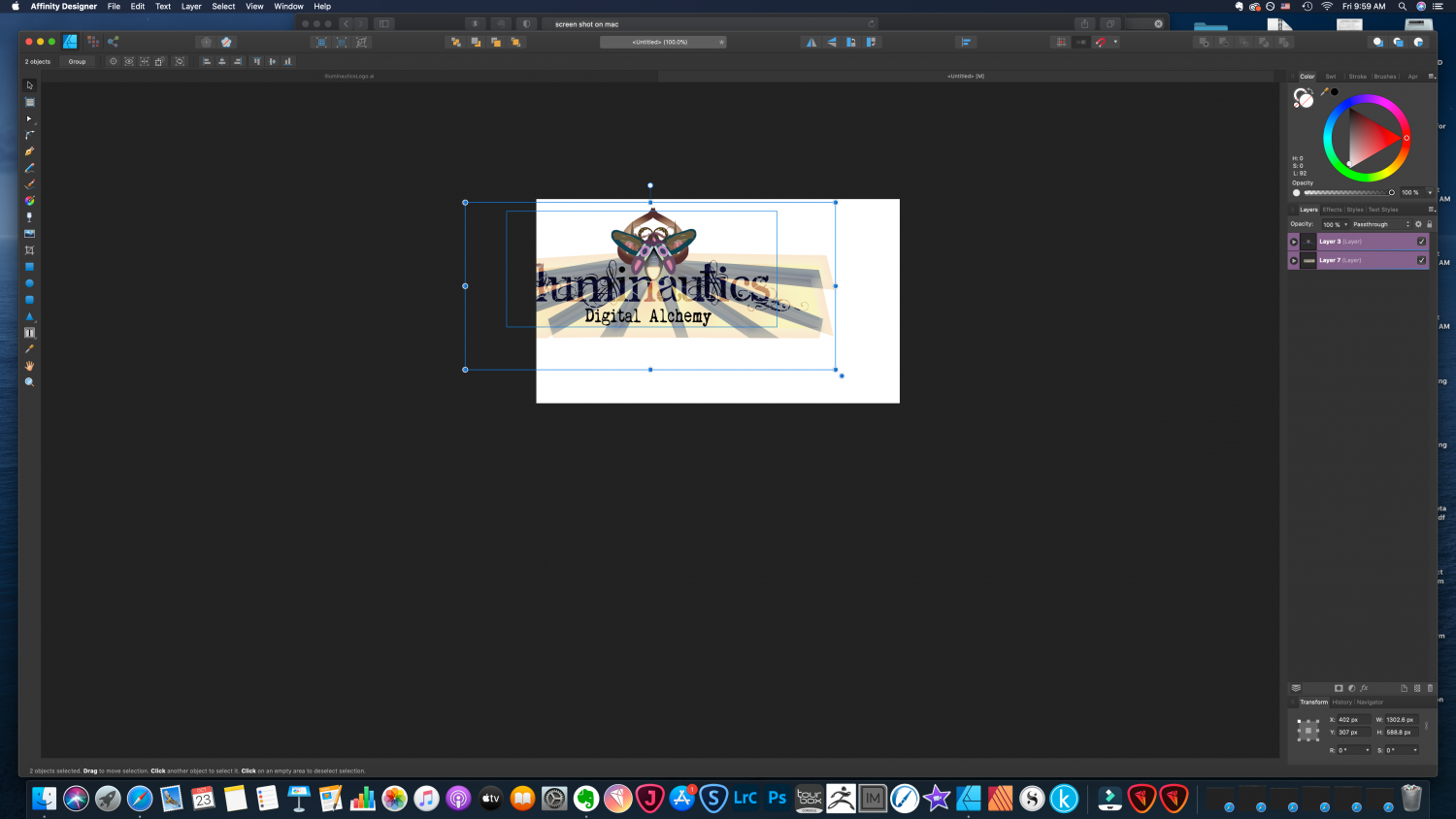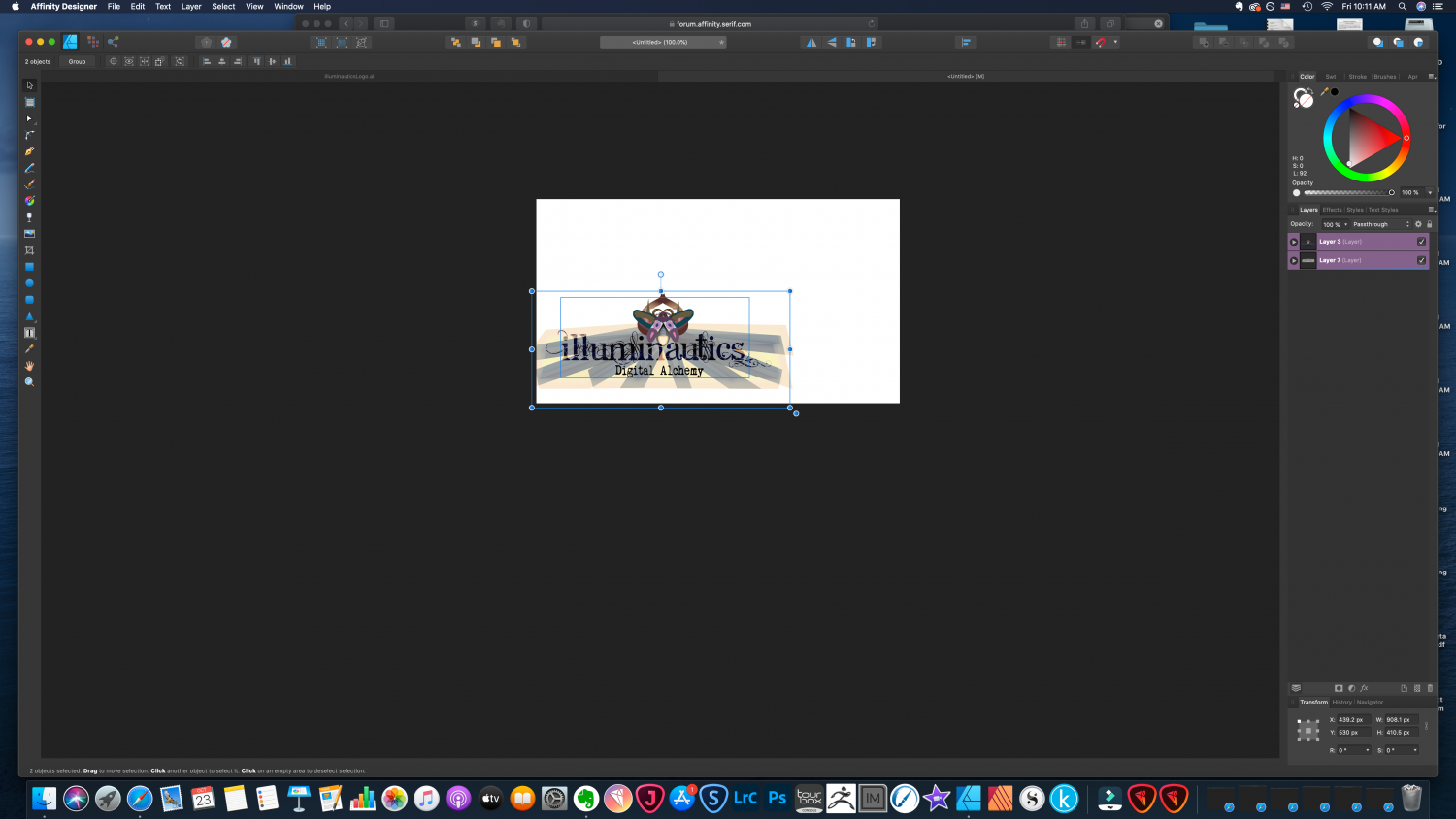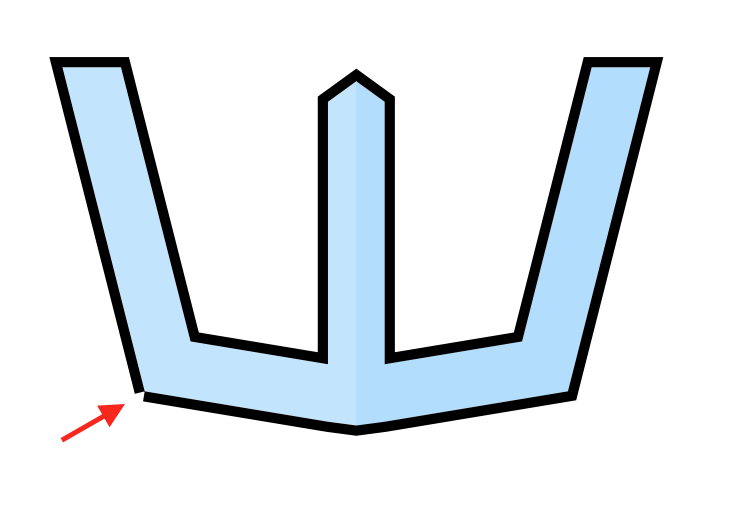Search the Community
Showing results for tags 'bug'.
-
I was trying to export a document using the font Montserrat and Open Sans (all downloaded from Google Fonts) in Affinty Designer, but it looks really strange. This is how it looks in the program: This is how it looks on PDF: Notice that the text in the yellow button next to the Direct Message icon became really different from the original text. And also the text close to the watch, below the main yellow text was white and became yellow too. Also, the padlock icon lost the FX when exported. Sorry for my bad english, it's not my primary language.
-
I use Affinity Designer to create files that I export – using "SVG (for export)" – for other apps, such as Cricut Design Space. The problem is that the Affinity Designer SVG export contains scientific e notation values like: <g id="topback" transform="matrix(-1,-1.22465e-16,1.22465e-16,-1,854.039,695.404)"> that other apps, specifically Design Space, chokes on. Trying to import that object into DS results in unusable, malformed objects. Sometimes I can "fix" it by editing the SVG file from the above, to: <g id="topback" transform="matrix(0,1,1,0,854.039,695.404)"> resetting the transform matrix, but it doesn't work for all objects, I haven't dug into how to map the space transforms properly, and I'm trying to avoid learning/doing that because this step is a huge pain. Based on a bunch of SVG parsers, the files are technically valid, and Affinity can re-import the SVGs, but I need them to work with the other apps. But this issue doesn't happen all the time and I can't figure out exactly what causes it to occur in the first place. Nor can I figure out how to fix it. I've tried deleting the offending object and re-creating them, but the new objects are affected exactly as the one it's replacing Any ideas would be very helpful. THANK YOU!
- 11 replies
-
- svg export
- svg exporter
- (and 8 more)
-
Just encountered a bug that seems to be still present with wrong color representation (washed out colors) when adding screenshots to Affinity Designer. It's a very similar issue as posted here and is not solved: https://forum.affinity.serif.com/index.php?/topic/85359-colour-distortion-drives-me-nuts/ https://marketmix.com/de/affinity-designer-photo-fehlfarben-screenshot/ (only German) Here the author sais that it was fixed in 1.6.1 but this bug seems to be back then because I still need to use the workaround from this blog. I try to give as many examples and data so you can track down this bug. - - - Steps to reproduce: 1. Create a screenshot with the mac internal screenshot tool (also tried another one from the app store with similiar results) with Command + Shift + 4 for example. 2. Save it to the desktop 3. Open Affinity Designer 4. Drag the screenshot from desktop into Affinity Designer (or File > New from clipboard or creating a canvas first and then pasting or dragging the screenshot) > Colors in AF are different than the screenshot with the mac preview app (see comparison screenshot below) File "Screenshot Original.png" is attached to this post so you can try it out. - - - Information: - iMac 21,5" Late 2015 - macOS Catalina 10.15.7 - Affinity Designer from the App Store (v1.8.6) - 2 Displays attached (HP E243i & Eizo EV2216W) Screenshot was taken on the internal iMac Display (and also tried it out with the external displays completely disconnected). - - - Screenshots to track down the issue: iMac Display Color Profile (German but relevant info is English) Information on the Screenshot itself (German but relevant info is color space RGB and color profile iMac) Affinity Designer Preferences Affinity Designer Document Setup Screenshot Comparison (left wrong color / right screenshot with mac preview app correct) - - - Other tests and workarounds: When inserting the same screenshot to Adobe XD or other Design apps the colors are fine. So seems to be an Affinity specific issue. Workaround is currently: Opening the screenshot with mac preview app > Tools > Assign profile > Color Sync Profile (Adobe RGB (1998)) > OK Then inserting it to Affinity Designer and the colors are fine and the document setup has set the profile to adobe instead of display. - - - Original Screenshot.png for you to try it out
-
Affinity Photo & Designer 1.8.3 (App Store installed) macOS Mojave 10.14.6 On my MBP either program was unable to open any editable file from anywhere on the file system nor could it save a new file that was created, resulting in a warning of "Permission Denied." However, on my Mac Pro, everything worked just fine. After some research someone said it was related to the number of fonts installed on the system. I confirmed this case by reducing the number of fonts to match my Mac Pro on my MBP. MBP had 2,800 fonts and the MP had 2,300 enabled. Also, an interesting side note, Publisher which I've purchase direct instead of the App Store had no problems with 2,800 fonts. No other program is affected by the number of fonts enabled, this bug should be fixed.
- 4 replies
-
- permissions
- permissions
-
(and 4 more)
Tagged with:
-
I've been having problems with the trackpad gestures, zoom in and out, and moving up and down, they are mixed, if I hold two fingers and move them up and down (the gesture that shuold be for scrolling up and down) it zoom in and out, and if I press with my two fingers and move them away from each other (gesture for zoom in and out) the document moves up and down. Moving sidewise is not affected. I've allready tried to fix it in the preference menu, but the only thing that kinda worked was restauring the preference setting to default, But after a few days the issue return, so I'm asking for help or for the developers to debug affinity designer, cuz it doesn't hapen in "photo"
-
Hello, I'm getting this error message whenever I am trying to save a document in Designer as .afdesign. I then click "Close" and the document shuts down. It saves the document as a .afdesign file I re-open it The file is corrupt Designer sort of freezes Troubleshooting: Re-installed Designer Shut down the program I am pretty sure I restarted my PC, but not 100% The problem about this It's super annoying that i can't re-open files I have to re-open Designer each time Does it happen 100% of the time? Well, yes. It did it ca. twice and then it worked again and now it's everytime. Please help me Thanks in advance - Vitus
-
I've been experiencing three issues related to the layers panel and layer selection ever since I updated to Big Sur. Firstly, when I have multiple layers selected and go to hide them all (by either clicking the checkmark or menu option), the last/bottom layer in layers panel will appear to be deselected even though it actually isn't and can still be manipulated along with the other layers that still appear selected. The second one is harder to describe and I haven't figured out what causes it yet (I think it might happen when quickly selecting between different layers in the layers panel, but don't quote me on that), but on multiple occasions I've had the current layer I'm working on appear to deselect itself (but like with the bug mentioned above, isn't and can still be manipulated). That layer, or any other layer, then can't be (re)selected, often thinking I want to change the layer name when I'm just trying to select it. It's like I'm soft locked out of the layers panel entirely. It isn't until I click an empty part on the canvas, to essentially to deselect everything and have nothing selected, am I able to work in the layers panel again. Lastly, when moving layers around in the panel, often times the layer I have selected won't move to its new location in the panel but the layer above or below it that isn't selected will be moved instead. It feels to me that I experience this more when I'm scrolling quickly through the layers while dragging a layer to its new spot in the panel and when I try to move a free layer into an group that's already been formed. Hopefully that all makes sense.
- 4 replies
-
- affinity designer
- macos
- (and 4 more)
-
Using Affinity Photo 1.8.6 on a fully updated Intel iMac running Mac OS 10.15.7 (19H15), I have the following repeatable bug: Closing an image that has changes that need to be saved causes the program to ask me if I want to save (which is normal), but after it saves and closes the image, I end up with a blank functionaless window where my open file used to be. Since the blank window is a bug, I can't even close it with command + W and must use the mouse to click the close box (frustrating). Steps to recreate: Open an image Draw some random lines somewhere Type command W to close The app asks if I want to save (which is expected) If I click Save, it saves and closes the document...but leaves the dead window behind. If I save the file first, then close with command W, everything works fine. This is a frustrating visual bug that I would love to have fixed. Incidentally, closing a changed with the close box instead of command W also leaves the dead window behind. So it's not just the keyboard shortcut.
- 2 replies
-
- affinity photo
- bug
-
(and 1 more)
Tagged with:
-
When using Gaussian Blur on objects in Affinity Designer (Mac version), I am always seeing an undesired color banding side effect, as you can see on the attached screen shot. I'm not encountering this issue with other graphical applications. As far as I can see it, the root cause seems to be that Designer does not use dithering for Gaussian Blur effects, even though it does dithering for gradients. Are there plans to address this? Or are there plans to support Photoshop filter effects in Designer, like it is already supported on Photo side? Because then we could use some Photoshop plugin as a workaround instead of using Designer's integrated blur effect. I find this an important issue to be addressed, since blur effects are some very fundamental technique for vector based illustrations. Using: Affinity Designer 1.8.4 on Mac.
- 1 reply
-
- affinity designer
- effect
-
(and 4 more)
Tagged with:
-
Hey there, I've just downloaded the new version of Affinity Publisher. So it would be version 1.7.1. I did not have access to beta prior. This is my first experience with the software. Since I opened it up, I've been having crash issues. Can barely get through adding images to one page and the spinning/not responding starts. Sometimes if I wait a while it works it's way out of it and sometimes not. I've been working for over an hour and have only gotten through page 3 of my document. I've been searching for solutions. Here's what I've tried so far. 1. Downloaded High-Logic and uninstalled a few hundred fonts that I wasn't using. 2. Checked the appdata folder for crash reports. Those folders are all empty 3. Held down the CTRL key when I started up Publisher and checked all boxes/ set it all back to defaults. The issue persists. As I've been typing this message, Publisher finally came out of it's spin, but I'm not going to get very far at this pace. Also, for some possibly further useful information, I had this problem sporadically with Designer and since that latest update, all those issues seem to have disappeared. I'm not sure if this is something going on with my PC or ? But I did see a forum thread somewhere that suggested this is not normal for Publisher and it should not be running this way. Any ideas or treasure trails you all can send me down to try and get this handled would be most appreciated. I was so excited to use this program and cut my time in half or more, but so far it's taking me more than twice as long to get anything done. Help?
-
High Sierra: When the Tools are a separate floating palette, if the main application window is dragged behind them (eg they're on a separate display), mouse released, then the main window is dragged again, it will capture the tools and drag them along with it. Problem manifests in 1.8.6 of Designer, Photo and Publisher.
-
I am experiencing a bug with the latest Affinity Designer version (1.8.5.703) : When exporting to a PDF file, the different layers are not exported as they should ... Once the PDF file is opened in Adobe Reader (and Adobe Illustrator) the layers preview pane does not show any layers. The bug is repeated as many times on Windows 10 version and this on two different computers. I specify that the bug occurs by using the menu> file> export ... as well as by using persona export ... This is particularly annoying when exporting PDF files with CutContour and cutting printing ... I hope you will solve the problem without difficulties and wish you good luck ... receive my full consideration. Guillaume
-
I've been piecing together a large image of the first level of the Sierra/GameArts video game "Thexder" from many screenshots. I open each screenshot PNG in Photo, crop off the bottom game UI, copy the image, close it, and paste that copied content into my main document. As I paste these shots into my primary document, the sharp solid colors in the image start to degrade at their edges, in ways you would see if you resampled an image to scale it. I am NOT scaling anything. Sometimes it's REALLY bad upon pasting a new chunk of image into the main document. In THIS specific case, it seems that undoing the paste, zooming WAY out in the document, and pasting again results in a correct paste (this time it pastes in at the top left corner of my document, where as before it pasted where I was working). Moving layers around shows the color shifts happening as part of rendering the layers on screen, but merging down, etc, will eventually start to show that the edges of hard color borders are "smudged" with slight color shifts. Anyone who plans to use Affinity Photo to create pixel art should beware. This could be especially problematic when changing between set palettes and full-color. It also has me wondering how much degradation is going on all the time. How much blur is Affinity Photo adding to everyone's images while they're working on them, unsuspectingly? I only noticed this because of working at the pixel level, zoomed in at them, and knowing the explicit limit of 16-colors in these screenshots (the game only shows 16 colors from an MCGA palette). My main document is a regular Affinity Photo document. I am importing PNG images from Boxer (DOSBox shell in Mac OS) which are 320x200. I've attached an image showing what's happening. I have zoomed way in so that you can see the individual pixels (very important with pixel art). The left side of the image shows sharper content while the right side has areas that have been through layer movement and merging down. One edge even turned partially transparent. EDIT: It seems to be getting progressively worse as I extend my canvas to the right and downward, as the older content to the upper left does not seem degraded.
-
Sadly not good experience while painting. like stroboscope with every brush move between halfres brush strokes. Keeping me back from using Photo more... macOS 10.15.7 iMac Retina 5K, 27-inch, 2017 Radeon Pro 580 8 GB flickering.mov
- 2 replies
-
- retina display
- painting
-
(and 1 more)
Tagged with:
-
zoom tool context toolbar bug: - also I would expect that I can drag the arrow to set the scale that way. it's stuck in place (just in some case it moves with mouse like on the beginning of screen recording) - you have to click somewhere beside. - slider with arrow doesn't reflect (update) when scale is changed in number-box next to it. Screen_Recording_2020-11-30_at_02_43_10.mov
- 1 reply
-
- context bar
- zoom tool
-
(and 2 more)
Tagged with:
-
Past 3 days encountering random crashes. Working on a simple node edit AD crashed, returning to the iPad’s Home Screen. Returning to the project it would randomly crash regardless of the attempted operation. Crash has been occurring after 3-8 mins of use. It consistently happens when attempting to return to my gallery from any project. I updated to iOS 14 2 days ago with the same results. App Store auto updates turned ‘on’. Help!
- 1 reply
-
- bug
- affinity designer
-
(and 3 more)
Tagged with:
-
TL;DR: Is there a way to add a background image to a document using a picture frame while avoiding the picture immediately becoming detached from the master? I ran into an issue where detaching an element on a master page resulted in the same element being detached when the styles are applied. It's a bit tricky to explain, but it basically boils down to problems with child masters carrying over too much information. Step 1: Created a master, on which I based all of my subsequent masters (Level 1). At some point I tested adding a background here and changed my mind. Only partially relevant to this conversation, but it does have some impact. Step 2: Created a child template by applying that master to another template. I have three templates created this way, each with a different background texture. (Level 2) Step 3: Applied Level 2 masters to child masters for slight variations among pages that share a textured background. (Level 3) Step 4: Created a few pages based on Level 3 masters. I didn't realize this until later, but adding a photo to a picture frame detaches the element from the master, and this change carries over across subsequent masters/pages. I see no way to fix this without entirely recreating the document, unless it is possible to "reattach" an element that was detached from the master. In the attached images, you can see that my change at Level 2 doesn't carry into the Level 3 master or the page based on the master. In other words, once a frame becomes detached from the master, it also becomes detached on child masters and pages.
- 1 reply
-
- affinity publisher
- bug
-
(and 3 more)
Tagged with:
-
I copied and pasted layers of vector art from an .ai file into my Designer document. When I resized the document to fit on my workspace, distortions in the design were introduced at particular points in the scaling process. Attached images: The first shows the original (correct) drawing. The second remains correct. The distortions occur around the "antennae" of the stylized insect in the 3rd and subsequent images, and appear as spike-like protrusions and odd scaling of the other elements of the drawing. I would hate to have to re-create this from scratch in Designer. How can I scale these vectors without creating distortions? Another question: I originally tried to work on my .ai file in Designer without copying and pasting the layers into a new document. When I tried to anchor the layers and resize the document, the artwork layers disappeared. The list of layers still showed them as existing, and supposedly visible, but neither the art nor its bounding boxes could be seen in the workspace, even when zoomed out. I have no clue why I am not able to resize the document without losing access to the layers.
-
Screenshot file names provide description to go with the description below. TIFF file exported from Capture One has a very strong moire pattern in the couch fabric that the subjects are sitting on. The moire is not apparent when editing in Capture One, but it is evident in the TIFF file opened by 2 of 3 downstream programs. See the steps below. 2 of 4 (including Affinity Photo) if you include opening the tiff file in CO20. I am not sure where the issue is since it doesn't appear in XnViewClassic, nor in Capture One if you open the TIFF file in C20. Details and screenshots included. I develop a RAW file in Capture One 20 When satisfied I process it, export to tiff There is NO moire pattern in the Capture One application I open the tiff file in Affinity Photo and there is a brutal moire pattern in the couch I open the tiff file in Windows Photo Viewer and there is a brutal moire pattern in the couch I open the tiff file in XnViewClassic and there is no moire pattern in the couch I open the tiff file in Capture One 20 and there is no moire pattern in the couch Affinity Photo 1.8.5.703 Capture One Details: Build: 13.1.3.13 (78b6a17) System Details: OS Name Microsoft Windows 10 Pro Version 10.0.19041 Build 19041 OS Manufacturer Microsoft Corporation System Type x64-based PC Processor AMD Ryzen 5 3600 6-Core Processor, 3600 Mhz, 6 Core(s), 12 Logical BIOS Version/Date American Megatrends Inc. 3.50, 2019-11-07 BaseBoard Product B450 TOMAHAWK MAX (MS-7C02) Platform Role Desktop Time Zone Pacific Daylight Time Installed Physical Memory (RAM) 32.0 GB Total Physical Memory 32.0 GB Available Physical Memory 22.4 GB Page File Space 4.75 GB [Display] Name NVIDIA GeForce GTX 1650 Adapter RAM (1,048,576) bytes Driver NV_DISPSI.INF_AMD64_47A7EA3F1B25EDD7 <<Monitor>> Benq SW271 _8507812_-_2020-Oct-11_-_Dev_2020_10_19_10-53-24.tif _8507812_-_2020-Oct-11_-_Dev_2020_10_19_10-53-24.tif
-
Hi All, Sorry, I'm not 100% sure how to properly word this, as I've not nailed down exactly what causes this to occur, but I've had a persistent albeit random issue trying to paint masks. Eventually, after doing a fair mount of painting/switching back and forth between black/white using the keyboard shortcut something happens and AP gets 'stuck'. Once the issue starts, white and black do the same thing and resetting the colors does not fix the issue. If they are stuck in 'hide mode' both colors hide and vice versa. I can save and restart, but the issue persists. However, sometimes, if I manually set the color to white/black the problem goes away, but that is not a guaranteed fix. I did just find that if I set both colors to nothing (red line though the circle) then manually change the slider for each color, one to white and one to black, it seemed to fix the issue. I'm fairly sure I've done that before and it did not fix the issue, but it's late and my memory is slipping. Hopefully someone else can replicate the issue, or tell me why it's happening, and how to never let it happen again System: Window 10 Pro: Version 2004, Build 19041.508 Affinity Photo: 1.8.5.703
- 2 replies
-
- mask layer
- masking
-
(and 2 more)
Tagged with:
-
All Affinity Programms are Black - Nvidia Surround
mondze posted a topic in V1 Bugs found on Windows
Affinity 1.8.5.703, Windows 10 64 bit, Intel I7 6700Q Nvidia Gforce 960M By using "Nvidia Surround" with 2 monitors Affinty goes black on right screen on the left side its working. Open in fullsize on left side | Works: Open in fullsize on right side | Don't work: If i use Microsoft PowerToy (Fanzy Zones) it works fine. Example 1 | 2 zones: Example 2 | 4 zones: -
Hello there, I was trying to enjoy using the Frankentoon Illustration brushes (on Windows Designer) but every time I switched back and forth between eraser and one of the more complex brushes I had to reselect and therefore reset brush size and changes I've made to the brush. After some testing I figured out the texture option is causing this problem because the textures won't get applied after switching back to the brush tool. However if I press "Invert" twice in the texture brush settings the brush works as intended again, but that just kills my workflow so is there any fix for this? I couldn't find anything about it after skimming the forum. Explanation of the pictures: 1.: stroke with brush; 2.: switch to eraser and erase a bit; 3.: switch back to brush and do another stroke After some more testing I found that this issue only occurs in brushes with more than one Texture applied, also non- Frankentoon brushes are affected too (tried with "Watercolours" defaults). I'm running the latest stable designer build on a AMD Ryzen 4700u, 16GB RAM Kind regards, RK




